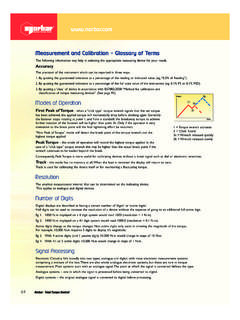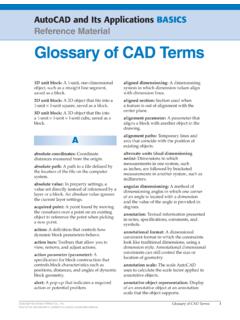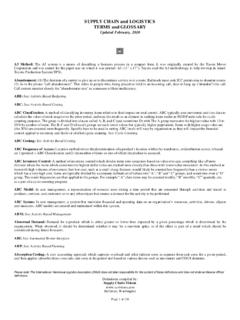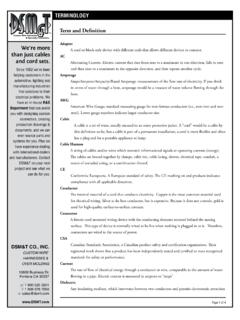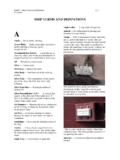Transcription of SUPPLY CHAIN MANAGEMENT TERMS and GLOSSARY
1 SUPPLY CHAIN MANAGEMENT . TERMS and GLOSSARY . Updated: February 2010. A. A3 Method: The A3 system is a means of describing a business process in a compact form. It was originally created by the Toyota Motor Corporation and was named for the paper size on which it was printed: A3 (11 x 17 ). Toyota used the A3 methodology to help develop its famed Toyota Production System (TPS). Abandonment: 1) The decision of a carrier to give up or to discontinue service over a route. Railroads must seek ICC permission to abandon routes. 2) As in the phrase "call abandonment". This refers to people who, being placed on hold in an incoming call, elect to hang up ("abandon") the call. Call centers monitor closely the "abandonment rate" as a measure of their inefficiency. ABB: See Activity Based Budgeting ABC: See Activity Based Costing ABC Classification: A method of classifying inventory items relative to their impact on total control.
2 ABC typically uses movement and cost data to calculate the value of stock usage over the prior period, and uses the result as an element in ranking items under an 80/20 Pareto rule for cycle counting purposes. The group is divided into classes called A, B, and C (and sometimes D) with The A group represents the highest value with 10 to 20% by number of items. The B, C and D (if used) groups are each lower values but typically higher populations. Items with higher usage value are (the 20%) are counted more frequently. Specific bars to be used in setting ABC levels will vary by organization as they will impact the financial control applied to inventory and the level of effort spent counting. Also see: Cycle Counting ABC Costing: See Activity Based Costing ABC Frequency of Access: Location method where the determination of a product's location within the warehouse, or distribution center, is based on 1) product's ABC Classification and 2) the number of times or rate of which the product is accessed.
3 ABC Inventory Control: A method of inventory control which divides items into categories based on value of usage, something like a Pareto division where the items which constitute the highest dollar value are tracked more closely than those with lower value movement. In this method an item with high volumes of movement, but low cost, such as a small cheap fastener, would likely be counted less frequently than a slower mover which has a very high cost. Items are typically divided by a company defined set of values into A , B and C groups, and sometimes even a D group. The count frequencies are then applied to the groups. For example A class items may be counted weekly, B monthly, C quarterly, etc. as a part of a cycle counting program. ABC Model: In cost MANAGEMENT , a representation of resource costs during a time period that are consumed through activities and traced to products, services, and customers or to any other object that creates a demand for the activity to be performed.
4 Definitions compiled by: Kate Vitasek CSCMP does not take responsibility for these definitions nor endorses these as official definitions except as noted. Page 1 of 212. SUPPLY CHAIN MANAGEMENT . TERMS and GLOSSARY . Updated: February 2010. ABC System: In cost MANAGEMENT , a system that maintains financial and operating data on an organization's resources, activities, drivers, objects and measures. ABC models are created and maintained within this system. ABI: See Automated Broker Interface ABM: See Activity Based MANAGEMENT Abnormal Demand: Demand for a product which is either greater or lower than expected by a given percentage which is determined by the organization. When observed, it should be determined whether it may be a one-time spike, or if the effect is part of a trend which should be considered during future forecasts.
5 ABP: See Activity Based Planning Absorption Costing: A cost accounting approach which captures overhead and other indirect costs as separate from unit costs for a given period, and then applies (absorbs) those costs into unit costs at the period end based on various factors such as movement and COGS elements. ACAT: See Acquisition Categories Acceptable Quality Level (AQL): In quality assessment, acceptable quality level, also known as assured quality level, describes the maximum number of defects acceptable during the random sampling of an inspection. Acceptable Sampling Plan: A quality MANAGEMENT procedure which defines the sample sizes and acceptable defect levels for validating quality of Acceptance Number: See Acceptable Quality Level Acceptance Sampling: A statistical quality control method which tests samples of products at defined points as opposed to testing each product.
6 Accessibility: The ability of a carrier to provide service between an origin and a destination. Accessorial Charges: A carrier's charge for accessorial services such as loading, unloading, pickup, and delivery. Also see: Upcharges Accessorial Fee: See Accessorial Charges Accessory: A choice or feature added to the good or service offered to the customer for customizing the end product. An accessory enhances the capabilities of the product but is not necessary for the basic function of the product. In many companies, an accessory means that the choice does not have to be specified before shipment but can be added at a later date. In other companies, this choice must be made before shipment. Definitions compiled by: Kate Vitasek CSCMP does not take responsibility for these definitions nor endorses these as official definitions except as noted.
7 Page 2 of 212. SUPPLY CHAIN MANAGEMENT . TERMS and GLOSSARY . Updated: February 2010. Accountability: The act of making a group or individual responsible for certain activities or outcomes. For example, managers and executives are accountable for business performance even though they may not actually perform the work. Accounts Payable (A/P): 1) a financial term referring to the amount of transactions which have been accrued but not paid to a vendor. 2) An accounting function Accounts Receivable (A/R): On a company's balance sheet, accounts receivable is the amount that customers owe to that company. Sometimes called trade receivables, they are classified as current assets assuming that they are due within one year. Accreditation: The process in which certification of competency, authority, or credibility is presented.
8 An example of accreditation is the accreditation of testing laboratories and certification specialists that are permitted to issue official certificates of compliance with established standards. Accredited Standards Committee (ASC): A committee of the ANSI chartered in 1979 to develop uniform standards for the electronic interchange of business documents. The committee develops and maintains generic standards (X12) for Electronic Data Interchange. Accumulation bin: An area where item to be used in assembly of a product are staged prior to work being done. Also see: Staging Accuracy: A value, usually expressed as a percentage, which expresses the level of precision incurred during transactions. An example would be seen when comparing actual inventory levels to what was expected from bookkeeping records.
9 ACD: See Automated Call Distribution ACE: See Automated Commercial Environment ACH: See Automated Clearinghouse Acknowledgment: Typically this is a response, either electronic or as a physical document, which confirms the receipt of an order from the supplier to the buyer. Acquisition Categories (ACAT): DoD ACAT 1 programs are Milestone Decision Authority Programs or programs designated ACAT 1 by the Milestone Decision Authority. Acquisition Cost: The net price plus other costs needed to purchase the item and get it to the point of use. These other costs can include: the item's purchasing costs (closing, research, accounting, commissions, legal fees), transportation, preparation and installation costs. Definitions compiled by: Kate Vitasek CSCMP does not take responsibility for these definitions nor endorses these as official definitions except as noted.
10 Page 3 of 212. SUPPLY CHAIN MANAGEMENT . TERMS and GLOSSARY . Updated: February 2010. ACSI: See American Customer Satisfaction Index Action Message: A system message usually created during MRP calculations to call attention to a current or potential problem and suggest corrective action. Action Plan: A specific method or process to achieve the results called for by one or more objectives. An action plan may be a simpler version of a project plan. Action Report: See Action Message Activation: TOC recognizes that it is possible to produce without contributing to throughput. TOC defines production that contributes to throughput as utilization. Production that does not contribute to throughput is known as activation. Activation is not desired because it not only fails to increase throughput, but it also increases inventory and operating expense.

